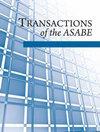Base Cutting Energy Consumption for Sugarcane Stools Using Contra-Rotating Basecutters
IF 1.4
4区 农林科学
Q3 AGRICULTURAL ENGINEERING
引用次数: 3
Abstract
HighlightsThis study focused on the base cutting energy consumption for sugarcane stools instead of single stalks, thus being more consistent with actual field harvesting.The energy consumption increased with increasing rotational speed (RS) and stool diameter (SD), while it decreased with increasing tilt angle (TA) and feed rate (FR).Each pair of levels of each factor was compared using Duncan’s multiple range test. Three factors (RS, SD, and FR) had significant effects on energy consumption at 95% confidence level, while one factor (TA) had no significant effect.The order of influence and the optimal combination of the four factors to minimize the energy consumed during base cutting were determined.Abstract. Previous studies on contra-rotating basecutter designs based on supported cutting have mainly focused on the base cutting energy consumption for single sugarcane stalks instead of sugarcane stools. However, in the actual base cutting process, a basecutter typically cuts multiple sugarcane stalks (in one sugarcane stool) simultaneously. Therefore, this study investigated how the rotational speed (RS) and tilt angle (TA) of the cutting discs, the sugarcane stool diameter (SD), and the feed rate (FR) affected the energy consumed when cutting cane stools using a contra-rotating cutting platform. Four single-factor experiments and an orthogonal experiment were performed using a Taguchi orthogonal experimental design, and each group was replicated five times. The results of the single-factor experiments showed that the energy consumption was proportional to RS and SD, while it was negatively correlated with TA and FR. The significance of the difference between each pair of levels of each factor was investigated using Duncan’s multiple range test. According to the results of the orthogonal experiment, RS, SD, and FR had significant influences on the base cutting energy consumption at the 95% confidence level; however, TA had no significant influence. The order of influence of the four factors was SD > FR > RS > TA (18.45 > 18.39 > 12.91 > 9.06), and the optimal factor-level combination for minimizing the cutting energy was RS2, TA4, SD1, and FR3 (200 rpm disc RS, 20° disc TA, 60 mm SD, and 1.0 m s-1 FR). An understanding of the relationships between energy consumption and its influencing factors can serve as a valuable reference for researchers seeking to optimize the design of contra-rotating basecutters, which could lead to increased energy efficiency and a reduction in energy consumption during sugarcane harvesting. Keywords: Contra-rotating basecutter, Energy consumption, Orthogonal experiment, Single-factor experiment, Sugarcane stools, Supported cutting.采用对转切基机的甘蔗凳切基能耗
本研究关注的是甘蔗粪便而不是单茎的基础切割能耗,因此与实际的田间收获更加一致。能量消耗随转速(RS)和粪便直径(SD)的增加而增加,随倾角(TA)和进料速率(FR)的增加而降低。采用Duncan多重极差检验比较各因子的每对水平。三个因素(RS、SD和FR)在95%置信水平上对能量消耗有显著影响,而一个因素(TA)没有显著影响。确定了四种影响因素的影响顺序,并确定了四种影响因素的最优组合,以最大限度地降低基切能耗。以往对基于支撑切割的对转切基机设计的研究主要集中在甘蔗单茎切基能耗上,而不是甘蔗粪便的切基能耗。然而,在实际的切基过程中,一个切基机通常同时切多根甘蔗茎(在一个甘蔗凳上)。因此,本研究研究了使用对转切割平台切割甘蔗凳时,切割盘的转速(RS)和倾角(TA)、甘蔗凳直径(SD)和进给速率(FR)对能量消耗的影响。采用田口正交试验设计,进行4个单因素试验和1个正交试验,每组重复5次。单因素实验结果显示,能量消耗与RS和SD成正比,与TA和FR呈负相关。采用Duncan 's多元极差检验考察各因素每对水平之间差异的显著性。正交试验结果显示,在95%置信水平下,RS、SD和FR对基材切削能耗有显著影响;而TA对其影响不显著。4个因素的影响顺序为SD > FR > RS > TA(18.45 > 18.39 > 12.91 > 9.06),最小切削能量的最佳因子水平组合为RS2、TA4、SD1和FR3 (200 rpm圆盘RS、20°圆盘TA、60 mm SD和1.0 m s-1 FR)。了解能量消耗及其影响因素之间的关系可以为研究人员寻求优化对旋转基切机的设计提供有价值的参考,这可能导致提高能源效率并减少甘蔗收获过程中的能量消耗。关键词:对转切基机,能耗,正交试验,单因素试验,甘蔗凳,支撑切割
本文章由计算机程序翻译,如有差异,请以英文原文为准。
求助全文
约1分钟内获得全文
求助全文
来源期刊

Transactions of the ASABE
AGRICULTURAL ENGINEERING-
CiteScore
2.30
自引率
0.00%
发文量
0
审稿时长
6 months
期刊介绍:
This peer-reviewed journal publishes research that advances the engineering of agricultural, food, and biological systems. Submissions must include original data, analysis or design, or synthesis of existing information; research information for the improvement of education, design, construction, or manufacturing practice; or significant and convincing evidence that confirms and strengthens the findings of others or that revises ideas or challenges accepted theory.
 求助内容:
求助内容: 应助结果提醒方式:
应助结果提醒方式:


